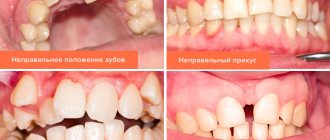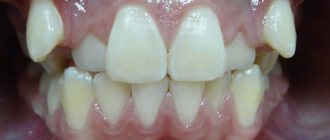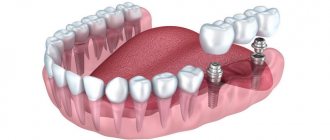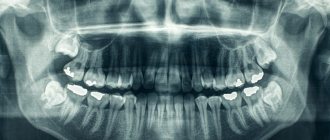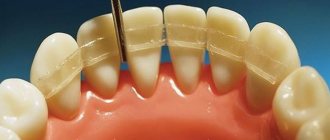In what cases is teeth straightening necessary?
Smooth and beautiful teeth are the dream of many people. After all, not everyone was given a perfect smile at birth. Dental abnormalities can be the result of poor heredity, trauma, or improper dental care in childhood. If you clearly see that your teeth are crowded, your teeth protrude greatly from the dentition, or there are other deficiencies, you should contact an orthodontist. Sometimes the problem is far-fetched, but only a specialist can determine this. A preliminary diagnosis will be made at the first appointment, and then the doctor will be able to offer treatment options.
How to care for trainers
Caring for jaw trainers is very simple and does not require special skills. It is available to patients of all ages. Follow simple rules:
- Always rinse the device after removing it from your mouth. Whenever it gets dirty, clean the trainer with a toothbrush and toothpaste, just as you would brush your teeth.
- Store the product in a special container to prevent dust, dirt and accidental damage.
- Do not chew, chew, or boil the apparatus. You need to rinse it with warm water, not cold or hot, otherwise you can ruin the plastic.
- If the trainer is damaged, you should immediately take it to the orthodontist so that the doctor can tell you whether you can continue to use the product or whether you need to buy a new one.
Is it possible to straighten teeth in adults?
Of course, treatment is faster in children and adolescents. This is due to the fact that up to the age of 25 in a person, the processes of bone tissue regeneration proceed faster, the ossification of bone sutures has not yet been completed, which means orthodontic treatment will be more effective. But don’t think that adults can’t be helped. Dentists have been successfully helping straighten teeth for patients of any age for a long time. It just takes a lot of time. Orthodontists typically recommend braces or aligners as options for straightening teeth in adults. In some cases, if only one or two teeth are misaligned, doctors may use veneers. These extremely thin dental coverings provide a quick solution to the problem of an imperfect smile. If the problem is several teeth and in addition the doctor diagnoses malocclusions, you will still have to use orthodontic structures.
What are malocclusions?
Types of bites
There are several malocclusions, depending on the position of the teeth relative to each other:
- Diastema. A small gap between the front incisors of the upper jaw. It is common in children, but usually goes away by adulthood. But for some, the diastema does not disappear even after the final change of bite, and as a result remains with the person for life.
- Tremes. Small spaces between all other teeth. Also common in children, but sometimes do not go away by adulthood.
- Crowding. With this anomaly, the teeth creep on top of each other due to the fact that there is not enough space for them in the jaw. Often, crowding appears late, when a person begins to erupt in numbers of eights - they press and squeeze the remaining teeth in the row.
- Transposition or dystopia. Teeth erupting in atypical places - above or below the dentition, or even on the palate. This anomaly occurs if there is too little space in the dentition, or if the rudiments of the teeth are not formed correctly. Sometimes supernumerary teeth, that is, extra teeth caused by genetic abnormalities, become dystopic.
- Distal bite. Reduction in the size of the lower jaw, due to which the lower teeth are located far behind the back ones, and the upper ones often protrude forward. This pathology is especially widespread among Europeans and Russians.
- Mesial bite. In this case, the situation is reversed - the upper teeth are hidden behind the lower teeth. This is often accompanied by crowding in the upper jaw, and on the contrary, tremors appear in the lower jaw.
- Open bite. A situation where the teeth do not close together and a gap forms between them. An open bite can occur on both the front and back teeth. It is rare, mainly due to unfortunate heredity, mouth breathing or thumb sucking.
- Deep bite. The upper teeth overlap the lower teeth too much, sometimes even resting on the mucous membrane of the lower jaw.
- Crossbite. The teeth do not close normally, but cross each other, randomly overlapping each other.
These pathologies can exist either separately or together. Sometimes they are practically invisible, and a person may not even know that the bite is broken, although in fact the anomaly exists and requires treatment.
Is it possible to straighten teeth at home?
Surely many people are interested in whether it is possible to straighten teeth at home. Don’t think that this can be done with the wave of a magic wand or using folk remedies. Teeth straightening at home means the use of aligners, trainers or elastopositioners. You will not be able to choose these designs yourself. You will need to contact an orthodontist - a doctor who straightens teeth, who will conduct an examination and tell you exactly whether removable structures will help in your case. Without a specialist, you won’t be able to cope with your problem - you shouldn’t even try. Attempting to straighten teeth without an orthodontist can lead to irreversible consequences.
How to straighten teeth for an adult?
Usually, correcting the bite and straightening the teeth is usually done in childhood. At an early age, these are removable structures, for example, trainers, lip bumpers or stretching plates; starting from the age of 10–11, braces can be installed. In some cases, you can do without braces, but the orthodontist will again tell you about this. For adults, it is more difficult to carry out the procedures. The fact is that at the age of 25, a person’s bone sutures harden, and any manipulations with the bite and other problems begin to take quite a lot of time. But this does not mean that you should give up dreams of a perfect smile. Answer to the question: “Is it possible to straighten teeth at 30 and beyond?” - of course, yes. At the first appointment, the orthodontist will tell you how to straighten teeth for an adult and what exactly to use in your case.
Causes of malocclusions
Types of malocclusion
There are many causes of malocclusion. They can be divided by age groups.
In childhood, the bite is disrupted for the following reasons:
- Various genetic abnormalities.
- Unlucky heredity - the parents have an incorrect bite, or the child received too small a jaw from his mother and too large teeth from his father.
- The child’s habit of breathing with his mouth open, sucking fingers or a pacifier after teething.
- Early loss of baby teeth due to caries or their removal instead of treatment.
- Incorrect attachment of the frenulum of the tongue or lips, creating pressure on the teeth.
If these negative factors were not present in childhood, then by adulthood a person’s bite usually remains normal. However, it may fail for the following reasons:
- Jaw injuries, especially those accompanied by tooth loss.
- Extraction or loss of teeth - adjacent teeth will move to take up the vacant space.
- Inflammation of the gums, accompanied by loss of bone tissue - teeth become loose and shift.
- Eruption of wisdom teeth, especially if there is no room for them in the jaw.
In this case, the bite can deteriorate at 20, 30 and even 40 years of age.
What ways are there to straighten teeth?
An orthodontist straightens teeth in several ways, as we have already mentioned. Let's talk about the most popular ones. The most popular way to straighten teeth is still the use of braces. Braces vary in material, location on the teeth and the presence of a ligature. However, regardless of the type, they regularly perform their functions - treating almost all malocclusions and incorrectly positioned teeth. You can inexpensively straighten your teeth and get rid of other problems by wearing metal vestibular (located on the outside of the dentition) braces.
If braces are not an option for you, you can straighten your teeth without braces using aligners. They solve several dental problems at once - they remove gaps between teeth, correct crowding and other malocclusions. One of the most popular brands is Invisalign aligners. Mouthguards are created taking into account individual characteristics, do not break and are almost invisible when worn. You can get used to them quite quickly. On average 10 – 12 hours. However, you will need to wear such mouthguards for more than 20 hours every day. You will need to accustom yourself to this, otherwise you will not achieve a good result.
Teeth straightening devices
There are two most popular orthodontic teeth straightening systems - braces and aligners (aligners). Each has its own characteristics. Braces have been used for many decades. They differ in several parameters, for example, in material. All types of braces are equally effective. This method of treatment is time-tested. In addition, braces systems are improved every year. Even metal braces have changed and turned from creepy “brackets” into a rather neat design. In parallel with bracket systems, other technologies are also developing. Thus, several years ago Invisalign aligners became widely used. Despite the high cost, their popularity has grown in a matter of months due to the following advantages:
- are created individually for each patient, taking into account his physiological characteristics
- invisible to others
- convenient for daily use
- do not require complex care
Braces
The designs allow you to level out any, even the most complex pathologies. The device consists of the braces themselves, which are individually attached to the teeth, and an arch - under its pressure, the dentition is rearranged into the correct position. Depending on the complexity of the anomaly, you will have to wear the device from six months to two years, regularly visiting a doctor. He will record changes and adjust the system. The main disadvantage of braces is their visibility, but today there are models that provide the opportunity to hide the treatment process from others. For example, ceramic and sapphire systems are white and blend in with the enamel, and lingual braces are completely invisible because they are installed on the inner wall of the teeth.
Aligners
Another device for straightening teeth is silicone aligners. They are made from transparent material based on the patient’s personal jaw casts, so they are completely invisible on the dentition. Another advantage of aligners is that they can be removed during meals or, for example, business negotiations. Treatment with aligners does not require frequent adjustments; it is enough to visit an orthodontist once every two months. You yourself change the devices from the kit every two weeks, the doctor only monitors the process. The device must be worn at least 22 hours a day, then the first results will appear within a month.
Prosthetics
For minor crooked teeth, crowns or veneers are used. They do not correct real teeth, but only mask malocclusions, but you can see the effect immediately after installing the structures. Crowns are used if the teeth are more than half destroyed - they are ground down and dentures identical to natural teeth are put on. Veneers are fixed in the smile area and hide aesthetic defects such as chips or gaps between teeth. The structures are created individually for each patient - the specialist selects the desired color and then gives them the anatomical shape of the surface of the teeth. However, these records have one significant drawback. Which? We'll talk about this below.
Massage can speed up healing
There are several ways to make the process of correcting dental anomalies less painful. One of them is massage of the gums and palate. Experts recommend using this method during oral care procedures. Gently, without force or sudden movements, massage the gums with a medium-hard brush, performing circular movements on each jaw. This will improve blood circulation, speed up the process of straightening the teeth, reduce pain, and if repeated regularly, strengthen the gums and prevent loosening of the teeth.
Surgical teeth straightening
Is it possible to straighten teeth surgically? We can say that it is impossible to surgically correct the position of the teeth, but it is possible to change the bite. The surgical method of bite correction is used only when orthodontic treatment alone is not enough.
Surgical correction of the bite, or orthognathic surgery, is only indicated for patients with noticeable skeletal deformities that result in abnormal jaw and chin size. The operation is performed in a hospital setting under general anesthesia; the entire procedure usually takes about 6 hours. Like any other major surgery, this procedure has a recovery period. The patient will be able to return to a full life after 3 to 4 weeks. However, in any case, treatment always begins with orthodontic teeth straightening, followed by a surgical stage, after which final orthodontic correction is necessary.
Options for children
Malocclusion in a child can manifest itself from the moment the first milk teeth erupt or during the period of age-related changes in permanent ones. But you can resort to bite correction with braces only after the final formation of the dentition, at about 14–16 years.
Until the required age is reached, other methods of straightening children's teeth without the use of braces are used.
These include:
- orthodontic plates;
- mouthguards-trainers;
- myogymnastics.
In some cases, it is possible to completely correct bite defects, in others, preventive measures help slow down the development of pathology and wait until it is possible to install braces without the development of complications.
Orthodontic plates
Plates
allow you to adjust the position of your teeth by widening or narrowing your jaws. They are silicone or plastic overlays on the palate or sublingual space. The force on the teeth is exerted using metal arches, springs and screws.
Removable orthodontic plate
There are removable and non-removable structures. The latter are securely fixed to the teeth with a system of locks and are capable of correcting severe defects. Removable ones are more convenient to use, they are attached with hooks, and allow the child to independently remove and install the device for eating or performing hygiene procedures.
Fixed orthodontic plate
Parents are often interested in whether it is possible to straighten teeth with a plate. For uncomplicated bite pathologies, timely installation of devices helps to completely solve the problem or prevent complications.
Pros:
- the method is used in early childhood, when other methods are not available;
- the ability to choose colors according to the child’s wishes;
- independent adjustment of the width of the plate using a special screw;
- short-term use (for removable plates).
Despite the impressive size of the device, the adaptation period passes quickly.
Minuses:
- injure the mucous membrane, causing stomatitis and inflammation;
- temporarily impair diction;
- noticeable to others;
- require constant wearing (for fixed structures).
The period of use of the plates is up to 2 years.
Price:
from 7 thousand rubles (depending on the complexity of the device), the cost of individual models reaches several tens of thousands.
Trainers for teeth
Trainers for teeth
- These are orthodontic aligners made of silicone or polyurethane. Dress for the night.
Trainers for teeth
The method of action is similar to aligners: linings of varying hardness - soft in the initial period and more elastic in the subsequent period - straighten the teeth into the correct position using light pressure. These devices are also used to consolidate the effect after wearing plates or braces.
Regular use of dental trainers relieves uncharacteristic muscle strain and normalizes natural nasal breathing, which, in turn, prevents the further development of pathology.
Even if it is not possible to straighten your teeth with trainers, they are a good way to prevent complications before installing braces.
How to wear trainers.
Mouthguards are installed on the upper and lower jaws simultaneously at night and for 2 hours during the day. During this period, you cannot talk or eat.
Fixation steps:
- Place the trainer in your mouth with the “marker” facing up.
- Touching the “marker” with the tip of your tongue, it is easy to clench your teeth, placing them inside the mouthguard.
- Close your teeth and lips tightly, breathe through your nose.
Difficulties may arise in the first days of use, then the process of installing the mouth guard occurs automatically.
Indications for using the trainer:
- mild pathologies;
- breathing, swallowing, diction problems;
- anomalies in the formation of the lower jaw, crooked teeth;
- presence of bad habits.
Also, wearing a mouth guard is indicated during the rehabilitation period after using plates and braces.
Contraindications:
- difficulty breathing, displacement of the nasal septum;
- severe malocclusion pathologies, including deep lateral bite.
Pros:
- are not visible to others, as they are used at night - during sleep;
- removable design – trainers can be easily removed without outside help;
- easy to use and maintain;
- low cost.
Minuses:
- low efficiency;
- must be removed while eating and communicating;
- impossible to securely fix during sleep (may fall out).
Price.
Trainers are popular due to their low cost. Universal sizes allow you to select a mouth guard according to the patient’s age and do not require individual manufacturing. The price of the device is from 2500 rubles.
Is it possible to straighten teeth with trainers? Unfortunately, serious malocclusion pathologies cannot be corrected with the help of these devices.
Preventive myogymnastics
An affordable way to prevent the development of bite pathologies is to perform special exercises aimed at developing the jaw muscles.
Myogymnastics in orthodontics
The use of myogymnastics in orthodontics helps speed up the process of bite alignment.
Types of exercises:
- for chewing muscles - with a deep bite;
- for the muscles responsible for the mobility of the lower jaw - with a distal bite;
- for circular muscles – with mesial occlusion, tremors, non-occlusion;
- for the tongue - stretching the frenulum.
Systematic implementation of myogymnastics in combination with hardware methods makes it possible to more effectively eliminate mild malocclusion pathologies in children.
In what cases is grinding necessary?
As we have already said, veneers are used to correct minor defects in the dentition - for example, chipped teeth, curvature of one or two teeth, as well as diastema. The main disadvantage of this method is the grinding of dental tissue to remove all irregularities. In addition, if you do not prepare your teeth before installing veneers, then after prosthetics they will look too convex and unnatural.
The structures themselves will last about ten years, after which they must be replaced with new ones, since turning teeth is an irreversible process.
Important!
To fix the veneers, the patient’s teeth are ground down by approximately 0.3 - 0.7 mm.
How do teeth become straight?
After the patient has been fitted with braces or has started treatment with aligners, the process of teeth straightening begins. The constant slight impact of the orthodontic system leads to the fact that the bone around the tooth changes: on the one hand it increases, and on the other it decreases. And the tooth moves to the desired point. It is important that the load is not excessive or insufficient - in either case, the treatment will not lead to the desired result. But an experienced orthodontist will not allow this to happen. It is to regulate the process of teeth straightening that you need to regularly visit your doctor. Treatment will last 1.5 – 2 years. After this, you will have to wear retainers for some time to fix the result.
How to straighten your front teeth?
In some cases, the dentition has slight deficiencies, for example with the front teeth. The orthodontist will tell you how to straighten your front teeth. He may recommend getting braces or treatment with aligners. However, sometimes cosmetic dentistry can help straighten the two front teeth. If there are no bite defects, you should consult an orthopedist - a doctor who specializes in prosthetics. He can offer the option of installing a veneer - an overlay 0.5 - 0.7 mm wide, which allows you to make your smile perfect. This technology has its pros and cons. An undoubted advantage is the speed with which the installation is carried out - just a few days, and the problem is solved. Here's a way to quickly straighten your teeth. Another plus is the service life. One of the disadvantages is the need to grind the tooth, and this is an irreversible process. In the same way, you can straighten 1 tooth, and not necessarily the front one. Sometimes an orthodontist suggests straightening the lower teeth without using braces or aligners and using veneers or lumineers. In each specific case, consultation with a doctor is necessary.
conclusions
Trainers for teeth straightening are a modern and relatively painless way to combat dental anomalies and bite problems. The orthodontist prescribes wearing the device if there are certain indications, for example, swallowing is impaired, teeth are displaced, and it is not possible to install braces. Contraindications for installing trainers include chronic nasal breathing problems and crossbite.
Trainers have many advantages: most often the choice in their favor is made due to the low price and safety of the system, since it does not affect the enamel and does not irritate the mucous membranes. But there are also disadvantages, the most negative is the slow effect on the dentition. But the effect will still be there. True, you need to choose the right product among all varieties.
The trainer is easy to get used to and easy to care for. But at the same time, wearing it gives much more than conventional braces: the device eliminates the cause of malocclusion and reduces the risk of similar problems occurring in the future. This is why many orthodontists prescribe wearing trainer systems, both separately and together with the installation of braces.
Where can I straighten my teeth and how long will it take?
It is better to choose a dental clinic for bite correction carefully. Ask your friends and acquaintances if they can recommend where to straighten your teeth. Get acquainted with clinic websites and reviews of doctors’ work. A little research will save you from possible disappointment. An extremely low price should alert you: in such cases, the clinic probably simply does not indicate the cost of additional procedures.
The duration of treatment and price depend on the diagnosis made by the orthodontist. Usually, the doctor can immediately determine exactly in what period it will be possible to straighten the teeth and how much time it will take. Usually, on average, it takes 1.5 – 2 years to straighten teeth with braces. It is impossible to say which braces straighten teeth faster. All braces are effective. Except that with plastic braces, treatment may take longer - they break, and the doctor has to replace parts of the structure, and this delays the treatment time. If you only need to fix one or two teeth and you decide to get veneers, the entire treatment is unlikely to take more than 2 weeks.
There are many ways to straighten your teeth. You just have to decide to change your smile, and after a while you will definitely achieve it. The question of whether teeth need to be straightened should not even arise. Of course you need it! With a beautiful smile, most likely, your attitude towards yourself and the world will change for the better!
In the modern world, teeth straightening is a standard procedure that millions of people of different ages undergo. The fact is that a beautiful smile is not only the key to personal success, but also a means of maintaining health. Some dental abnormalities can cause diseases of various body systems. If you are looking after your health, you should not ignore the presence of dental anomalies. Straightening your teeth and making your smile perfect is not so difficult, and the result will delight you for the rest of your life!
Why is it necessary to correct your bite?
If a malocclusion bothers a person from an aesthetic point of view, he will, of course, want to correct it. But there are people who do not care about their crooked teeth, and it seems that in this case it is not worth starting orthodontic treatment. But in fact, an incorrect bite can cause other problems besides aesthetic ones.
Due to the fact that the teeth are positioned incorrectly, the chewing load is abnormally distributed between them. As a result, some teeth wear down, while others are less involved in chewing, which is why the bone tissue underneath them atrophies. This leads to frequent caries, sensitivity and loose teeth. In addition, protruding teeth can injure the cheeks, gums and tongue, causing various inflammations to appear in the mouth.
With an incorrect bite, not only the teeth are incorrectly positioned, but also the jaws themselves. Because of this, the functioning of the temporomandibular joint is disrupted. This leads to problems opening the mouth, clicking of the jaw, and sometimes even severe pain.
Among other things, malocclusion can cause two more serious global problems:
- Gastrointestinal diseases. Sometimes people with uneven teeth find it difficult to chew food thoroughly. As a result, it enters the stomach insufficiently crushed, causing frequent disorders and other problems.
- Headache. Due to improper jaw alignment, people with bad teeth often suffer from migraines and pain for no apparent reason.
Well, the last but not least important problem is that an incorrect bite interferes with prosthetics. When one or more teeth are lost due to malocclusion, it is often difficult to place a bridge, crown or implant - the neighboring teeth get in the way. And since almost everyone has to get dentures as they age, an incorrect bite can make this process much more difficult, so it’s best to take care of correcting it in advance.
